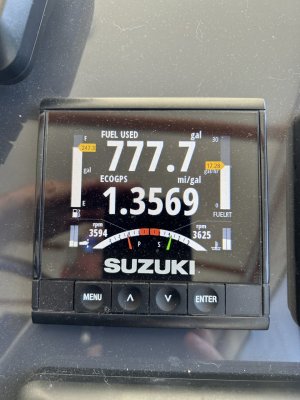Sharphooks
Well-Known Member
Four boats ago, I had a 19 foot Arima. After a ferry ride to Nanaimo and a tow to Ucluelet I spent all my fishing time on a piece of water called La Perouse Bank. It lies approx.. 10 miles off Amphitrite Lighthouse in the Straits of Juan de Fuca, an immense plateau teeming with herring and back then (the good old days) also teeming with sardines.
It’s a rich feeding ground for salmon and humpback whales that feed on the herring and sardines, and for orcas that feed on the salmon. It was named after a French explorer.
One day, while boat camping in a small bay on the outskirts of Ucluelet , I saw a gorgeous commercial troller that resembled the wing of a gull. Impeccably maintained with a snow white paint job, it was named LaPerouse. I vowed that day that if I ever purchased another boat, it would be named LaPerouse. Fast forward a couple of years later. I got caught in a southeast blow in Queen Charlotte Strait and realized a 19 foot boat did not belong in the waters I was now navigating. I returned to my home and with no hesitation bellied up to the bar for a 22 foot Arima and had the pleasure of naming it LaPerouse.
That boat served me well until on one of my trips up to Central Coast, I got caught in another brutal Southeaster in Millbanke Sound and for three hours, was pretty confident my puppy and I would not survive the storm.
We did but that was it for LaPerouse. As soon as I returned back home I pulled the trigger on a 26 footer
I named that boat La Boussole (Compass) which was the name of the ship LaPerouse captained until it sank on a reef off Vanikoro.
So earlier this year I once again stepped up for a bit larger boat and thought it was fair game to again, name the new boat LaPerouse.
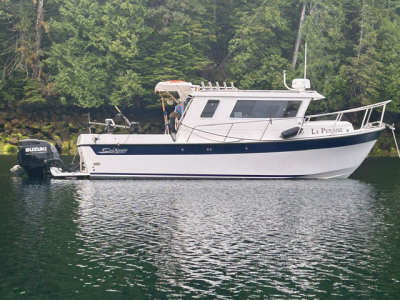
I know way more about LaPerouse now. I have read numerous books about him, watched numerous video presentations, and can’t think of a better way to pay homage to a historical figure who exemplified not only the spirit of exploration but more to the point, was a true humanist in the Renaissance tradition. He respected the indigenous tribes he came across in his exploration of the Pacific Northwest coast and treated them as equals.
LaPerouse greatly admired Captain James Cook and followed in his footsteps. His ship La Boussole and its partner ship Astrolabe were manned with a top-class group of scientists from the fields of astronomy, mathematics, geology, mineralogy and botany. Their mission was to study the geography of the Pacific, improve the charts that existed at the time, and seek out trade opportunities from the far north to Australia and from Asia to America.
In France he’s a rockstar. Prior to his explorations of the New World he was a master military naval strategist in the Seven Year War against the British. He gained a reputation for being a stern but always fair captain to his crew. To the British he was regarded as a worthy but fair opponent. He treated the British prisoners he took after winning sea battles with respect, had his surgeons treat their wounds, and kept them healthy for later prisoner exchanges with London.
So why the back story on LaPerouse?
While dodging another Southeaster two weeks ago, I was tucked in to an anchorage in Rescue Bay off the northern tip of Susan Island. It was raining buckets, Milbanke Sound was a whirling dervish of 30 knot wind against a 10 knot ebb tide——my absolute nemesis. So there I was all by my lonesome in a peaceful hidey-hole out of that storm, playing my guitar, sipping some good wine and minding my own business when a huge snow white cruiser came into the the bay and dropped its hook within hand-grenade distance of my boat.
Uh oh....there goes the neighborhood I remember thinking. There’ll be the cocktail chatter on the poop deck and gen-sets a blazing all night long, two absolute givens of the cruiser set that I’d up until then successfully dodged on this particular trip.
I was wrong. The cruiser dropped its anchor and then went quiet as a mouse. Wow, who could that be I remember thinking. Not normal cruiser behavior.
I trained my binoculars on its name plate
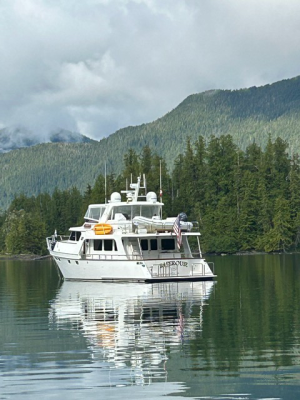
What were the chances of that happening, I asked myself. Another LaPerouse!
I later heard that the skipper took note of the name of my boat and tried to hail me on VHF but I’d powered off my radio. But lucky me---I ran into LaPerouse in Shearwater on the way south and got to shake the skipper’s hand on the dock. He was a French guy, Monsieur Marc Onetto, and with his cruiser, he took friends on as passengers and duplicated portions of LaPerouse’s Pacific Northwest explorations. And the big surprise for me---Monsieur Onetto is an active member of the LaPerouse Society in Albi, France. He gives presentations on Laperouse all over the world.
And every year the LaPerouse Society get together for a huge banquet with the Tlingit tribe from Lituya Bay, Alaska, where LaPerouse had visited in 1786 (and lost 21 men who perished in small boats during a violent tide and wind event where Lituya dumps into the Pacific through a narrow channel)
Meeting M. Onetto and hearing all the LaPerouse stories from an inside source was a great way to end the trip. I’d been on the water for 30 days and I’d had a phenomenal trip and this was the cherry on top for me
With that chance meeting of LaPerouse and M. Onetto, what better time then to begin my southbound push back towards Cape Caution?
And I’d also had this type of morning where I decided to finally set aside the gaff and pick up a net——once that happens the clock is ticking on the groceries
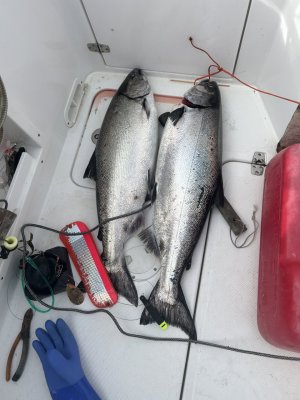
I also had to remind myself that even though Port Hardy was a one or a two day run depending on the sea state at Cape Caution, I didn‘t pull my boat out at Port Hardy any more and drag it home on a trailer like I used to in the good old days.
I still had multiple sets of big pieces of water waiting for me. The slow-boil of anxiety started in on me again but I’ve now learned that the most expedient way to deal with nav anxiety is to throttle down and go meet the gates head on and get them behind you.
I had been very lucky this trip dodging wind and storms. Part of that was luck and part of it was experience—-knowing where not to be when the wind started blowing against any given tide.
But my luck finally ran out after clearing US customs in Roche Harbor
My original plan was to cross the Strait of Juan de Fuca from Haro and San Juan Strait and go across to Port Townsend which would get me to Admiralty Inlet and finally, Puget Sound and to my dock but it was late afternoon and Weather Canada had announced a 25 knot blow in the Strait. It was expected to last for the next two days, with a possible deterioration to 30-35 knots.
So I navigated through the San Juan Islands, all new water for me, but protected and a good place to be for the conditions in the Strait. When I got to Rosario Strait my intention was to motor to LaConner and take an inland channel through downtown LaConner to avoid Deception Pass which is another “gate” , especially during a big tide change.
But Rosario Strait was a duck pond. Smooth sailing. I changed my plan on the fly and decided to take a chance and go around the west side of Whidbey Island instead of going to LaConner.
This was a big mistake, driven by a complete ignorance of how a big NW blow in the Strait of Juan de Fuca will effect the eastern entrance of the Strait, effectively the coast of Whidbey Island.
As I approached the bend in the arm of Whidbey the waves started growing and capping. I remember thinking: ok ….you have a big boat now. You’re going to finally see how it handles big water.
What I wasn’t expecting —- as soon as I went around the arm bend of Whidbey and started heading south east, I had a full set of 6 to 8 foot quartering seas coming at my boat out of the northwest in off the Strait. My boat performs best with tabs down and before I had a chance to change that I skated sideways down the face of a 6 footer and stuffed the bow of Laperouse deep into blue water.
That was a sobering moment. I clearly saw how that same move on a bigger wave could easily compromise the stability of the boat. I got the tabs up and trimmed up the outboards but even with the new bouncier attitude of the bow, I stuffed it again.
The next two hours were brutal. I was held to chopping the throttle to power up the backside of the waves and try and stay there without going over the top down into the trough while holding the boat at a 45 degree angle to each wave. This maneuver is a bit easier on a true following sea but these were quartering seas. And rolling in precisely the same direction I needed to go. In retrospect I should have tacked like a sailboat but I had no idea what the sea state would be if I prolonged my exposure. I had no choice but to maintain my course, chopping the throttles, doing my best not to stuff the bow again. I’ll admit the term “pitch-poling” came to mind multiple times during that part of the trip
Three hours later I pulled up to my dock and tied LaPerouse fast to the cleats we’d untied from over a month ago. A huge relief to have made it through that quartering sea chapter. And now….a new bundle of experience to tuck away in the nav file between my ears for what to do (or not do) the next time I find myself and my boat in similar circumstances.
And last but not least, I got the joy of seeing a very happy puppy dog. She yelped with glee as she felt the firm dock under her paws and raced up the stairs into my living room to promptly fall asleep under her favorite coffee table.
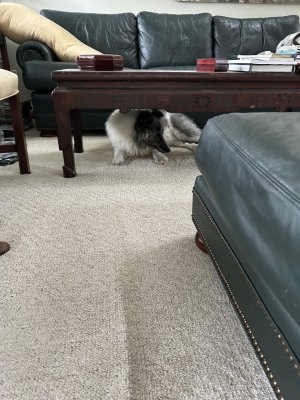
It’s a rich feeding ground for salmon and humpback whales that feed on the herring and sardines, and for orcas that feed on the salmon. It was named after a French explorer.
One day, while boat camping in a small bay on the outskirts of Ucluelet , I saw a gorgeous commercial troller that resembled the wing of a gull. Impeccably maintained with a snow white paint job, it was named LaPerouse. I vowed that day that if I ever purchased another boat, it would be named LaPerouse. Fast forward a couple of years later. I got caught in a southeast blow in Queen Charlotte Strait and realized a 19 foot boat did not belong in the waters I was now navigating. I returned to my home and with no hesitation bellied up to the bar for a 22 foot Arima and had the pleasure of naming it LaPerouse.
That boat served me well until on one of my trips up to Central Coast, I got caught in another brutal Southeaster in Millbanke Sound and for three hours, was pretty confident my puppy and I would not survive the storm.
We did but that was it for LaPerouse. As soon as I returned back home I pulled the trigger on a 26 footer
I named that boat La Boussole (Compass) which was the name of the ship LaPerouse captained until it sank on a reef off Vanikoro.
So earlier this year I once again stepped up for a bit larger boat and thought it was fair game to again, name the new boat LaPerouse.

I know way more about LaPerouse now. I have read numerous books about him, watched numerous video presentations, and can’t think of a better way to pay homage to a historical figure who exemplified not only the spirit of exploration but more to the point, was a true humanist in the Renaissance tradition. He respected the indigenous tribes he came across in his exploration of the Pacific Northwest coast and treated them as equals.
LaPerouse greatly admired Captain James Cook and followed in his footsteps. His ship La Boussole and its partner ship Astrolabe were manned with a top-class group of scientists from the fields of astronomy, mathematics, geology, mineralogy and botany. Their mission was to study the geography of the Pacific, improve the charts that existed at the time, and seek out trade opportunities from the far north to Australia and from Asia to America.
In France he’s a rockstar. Prior to his explorations of the New World he was a master military naval strategist in the Seven Year War against the British. He gained a reputation for being a stern but always fair captain to his crew. To the British he was regarded as a worthy but fair opponent. He treated the British prisoners he took after winning sea battles with respect, had his surgeons treat their wounds, and kept them healthy for later prisoner exchanges with London.
So why the back story on LaPerouse?
While dodging another Southeaster two weeks ago, I was tucked in to an anchorage in Rescue Bay off the northern tip of Susan Island. It was raining buckets, Milbanke Sound was a whirling dervish of 30 knot wind against a 10 knot ebb tide——my absolute nemesis. So there I was all by my lonesome in a peaceful hidey-hole out of that storm, playing my guitar, sipping some good wine and minding my own business when a huge snow white cruiser came into the the bay and dropped its hook within hand-grenade distance of my boat.
Uh oh....there goes the neighborhood I remember thinking. There’ll be the cocktail chatter on the poop deck and gen-sets a blazing all night long, two absolute givens of the cruiser set that I’d up until then successfully dodged on this particular trip.
I was wrong. The cruiser dropped its anchor and then went quiet as a mouse. Wow, who could that be I remember thinking. Not normal cruiser behavior.
I trained my binoculars on its name plate

What were the chances of that happening, I asked myself. Another LaPerouse!
I later heard that the skipper took note of the name of my boat and tried to hail me on VHF but I’d powered off my radio. But lucky me---I ran into LaPerouse in Shearwater on the way south and got to shake the skipper’s hand on the dock. He was a French guy, Monsieur Marc Onetto, and with his cruiser, he took friends on as passengers and duplicated portions of LaPerouse’s Pacific Northwest explorations. And the big surprise for me---Monsieur Onetto is an active member of the LaPerouse Society in Albi, France. He gives presentations on Laperouse all over the world.
And every year the LaPerouse Society get together for a huge banquet with the Tlingit tribe from Lituya Bay, Alaska, where LaPerouse had visited in 1786 (and lost 21 men who perished in small boats during a violent tide and wind event where Lituya dumps into the Pacific through a narrow channel)
Meeting M. Onetto and hearing all the LaPerouse stories from an inside source was a great way to end the trip. I’d been on the water for 30 days and I’d had a phenomenal trip and this was the cherry on top for me
With that chance meeting of LaPerouse and M. Onetto, what better time then to begin my southbound push back towards Cape Caution?
And I’d also had this type of morning where I decided to finally set aside the gaff and pick up a net——once that happens the clock is ticking on the groceries

I also had to remind myself that even though Port Hardy was a one or a two day run depending on the sea state at Cape Caution, I didn‘t pull my boat out at Port Hardy any more and drag it home on a trailer like I used to in the good old days.
I still had multiple sets of big pieces of water waiting for me. The slow-boil of anxiety started in on me again but I’ve now learned that the most expedient way to deal with nav anxiety is to throttle down and go meet the gates head on and get them behind you.
I had been very lucky this trip dodging wind and storms. Part of that was luck and part of it was experience—-knowing where not to be when the wind started blowing against any given tide.
But my luck finally ran out after clearing US customs in Roche Harbor
My original plan was to cross the Strait of Juan de Fuca from Haro and San Juan Strait and go across to Port Townsend which would get me to Admiralty Inlet and finally, Puget Sound and to my dock but it was late afternoon and Weather Canada had announced a 25 knot blow in the Strait. It was expected to last for the next two days, with a possible deterioration to 30-35 knots.
So I navigated through the San Juan Islands, all new water for me, but protected and a good place to be for the conditions in the Strait. When I got to Rosario Strait my intention was to motor to LaConner and take an inland channel through downtown LaConner to avoid Deception Pass which is another “gate” , especially during a big tide change.
But Rosario Strait was a duck pond. Smooth sailing. I changed my plan on the fly and decided to take a chance and go around the west side of Whidbey Island instead of going to LaConner.
This was a big mistake, driven by a complete ignorance of how a big NW blow in the Strait of Juan de Fuca will effect the eastern entrance of the Strait, effectively the coast of Whidbey Island.
As I approached the bend in the arm of Whidbey the waves started growing and capping. I remember thinking: ok ….you have a big boat now. You’re going to finally see how it handles big water.
What I wasn’t expecting —- as soon as I went around the arm bend of Whidbey and started heading south east, I had a full set of 6 to 8 foot quartering seas coming at my boat out of the northwest in off the Strait. My boat performs best with tabs down and before I had a chance to change that I skated sideways down the face of a 6 footer and stuffed the bow of Laperouse deep into blue water.
That was a sobering moment. I clearly saw how that same move on a bigger wave could easily compromise the stability of the boat. I got the tabs up and trimmed up the outboards but even with the new bouncier attitude of the bow, I stuffed it again.
The next two hours were brutal. I was held to chopping the throttle to power up the backside of the waves and try and stay there without going over the top down into the trough while holding the boat at a 45 degree angle to each wave. This maneuver is a bit easier on a true following sea but these were quartering seas. And rolling in precisely the same direction I needed to go. In retrospect I should have tacked like a sailboat but I had no idea what the sea state would be if I prolonged my exposure. I had no choice but to maintain my course, chopping the throttles, doing my best not to stuff the bow again. I’ll admit the term “pitch-poling” came to mind multiple times during that part of the trip
Three hours later I pulled up to my dock and tied LaPerouse fast to the cleats we’d untied from over a month ago. A huge relief to have made it through that quartering sea chapter. And now….a new bundle of experience to tuck away in the nav file between my ears for what to do (or not do) the next time I find myself and my boat in similar circumstances.
And last but not least, I got the joy of seeing a very happy puppy dog. She yelped with glee as she felt the firm dock under her paws and raced up the stairs into my living room to promptly fall asleep under her favorite coffee table.

Last edited:


